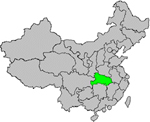
The Yeren, or wildman, is a yet undiscovered bipedal hominid reported to reside in the mountainous and forested regions of China. The Yeren’s height often ranges between 6 to 9 feet and is said to be covered from head to toe in reddish brown hair. It is said to have a sloping forehead which rises up above the eyes like a humans, its eyes are set deep and its whole face, with the exception of its nose and ears, is covered in short hairs. The Yeren’s arms hang below its knees; its hands are about half a foot long and its thumbs only slightly separate from its fingers.
The Yeren has been a part of the folklore of southern and central China for centuries. Ancient Chinese literary works and folk legends include references to big hairy man like creatures which live in the vast forests of the Quinling Bashan Shennongjia, a mountain region of central China. Roughly 2,000 years ago, during the Warring States period, Qu Yuan, the statesman poet of the State of Chu, referred in his verses to mountain ogres. His home was just south of Shennongjia, in what is today the Zigui country of the Hubei province. During the Tang Dynasty, the historian Li Yanshou, in his Southern History, describes a band of hairy men in the region of modern Jiangling country, also in the Hubei province.  The Hubei province its self is home to the Shennongjia Mountains, an area approximately 1,250 square miles that is comprised of steep, rugged mountains reaching up to 8,000 feet with peaks as high as 10,000 feet. Areas above 6,000 feet retain a temperature similar to early winter even while the surrounding lower lying hills swelter. This constant, year round, cool climate has resulted in the growth and survival of a unique and diverse ecosystem. The area is home to rare and exotic woods, including the arrow bamboo which makes high quality paper and provides food for China’s giant pandas. This region is also full of plant life sometimes referred to as living fossils, including the metasequoia, the dove tree and the Chinese tulip tree. The Shennongjia region contains several rare animals as well, including a white bear, the giant panda, the takin and the golden monkey, some of these species are found no where else in the world and sightings of the Yeren are most frequent in this diverse area as well.
The Hubei province its self is home to the Shennongjia Mountains, an area approximately 1,250 square miles that is comprised of steep, rugged mountains reaching up to 8,000 feet with peaks as high as 10,000 feet. Areas above 6,000 feet retain a temperature similar to early winter even while the surrounding lower lying hills swelter. This constant, year round, cool climate has resulted in the growth and survival of a unique and diverse ecosystem. The area is home to rare and exotic woods, including the arrow bamboo which makes high quality paper and provides food for China’s giant pandas. This region is also full of plant life sometimes referred to as living fossils, including the metasequoia, the dove tree and the Chinese tulip tree. The Shennongjia region contains several rare animals as well, including a white bear, the giant panda, the takin and the golden monkey, some of these species are found no where else in the world and sightings of the Yeren are most frequent in this diverse area as well.
Regional officials have recorded nearly four hundred sightings in and around this region since the 1920’s; with a number of these sightings being reported by very credible eyewitnesses. In 1940, biologist Wang Tselin claimed to have examined the corpse of a Yeren that had been killed in the Gansu region. He stated that the specimen was a female, over 6 feet tall, with striking features that appeared to be a cross between ape and human. Also Geologist Fan Jingquan reported seeing a pair of Yeren, what he thought was a mother and son, in the forests of the Shanxi province in 1950.  In 1961, a team of road builders reportedly killed a female Yeren in the forests of Xishuang Banna. Officials from the Chinese Academy of Sciences where called out to investigate the creature, however when they arrived the body had disappeared. The team of scientists concluded that the creature, which was described as approximately 4 feet tall, had been an ordinary gibbon. But twenty years later, a journalist who claimed to have been involved in the investigation came forward to claim that the creature killed was not a gibbon, but an unknown animal of human shape.
In 1961, a team of road builders reportedly killed a female Yeren in the forests of Xishuang Banna. Officials from the Chinese Academy of Sciences where called out to investigate the creature, however when they arrived the body had disappeared. The team of scientists concluded that the creature, which was described as approximately 4 feet tall, had been an ordinary gibbon. But twenty years later, a journalist who claimed to have been involved in the investigation came forward to claim that the creature killed was not a gibbon, but an unknown animal of human shape.
On May 14th 1976, six men from the Shennongjia forestry region were driving along a highway near Chunshuy, a village between Fangxian country and Shennongjia, when they came across a strange tailless creature covered in reddish fur illuminated in the headlights of their car. This incident sparked a great degree of public interest and lead to a group of scientists and the army mounting several expeditions into the forest, including one massive expedition of over 100 members comprised of scientists, photographers and special infiltration teams of soldiers with rifles, tranquilizer dart guns, tape recorders and hunting dogs. Though the search did not bring back any solid proof, at one point during the expedition a search party did encountered a Yeren, but as they moved closer to capture the creature an anxious solider reportedly shot himself in the leg, the shot brought expedition members from all directions to their location and presumably scared the Yeren away.  One of the closest thing to solid physical evidence of the Yeren’s existence was brought to light in 1980 in the form of the preserved hands and feet of an unknown hominid creature. Reportedly, villagers had killed the Yeren in the Zhejiang province in 1957, and a biology teacher had the foresight to remove and preserve the extremities. However upon examination of the hands and feet, researcher Zhou Guoxing, though not 100% sure, announced that they had come from a large macaque monkey.
One of the closest thing to solid physical evidence of the Yeren’s existence was brought to light in 1980 in the form of the preserved hands and feet of an unknown hominid creature. Reportedly, villagers had killed the Yeren in the Zhejiang province in 1957, and a biology teacher had the foresight to remove and preserve the extremities. However upon examination of the hands and feet, researcher Zhou Guoxing, though not 100% sure, announced that they had come from a large macaque monkey.
Another large scale expedition to find the Yeren was launched in 1980 and operated until 1985 near Songbai in the Shennongjia Forest. More than two hundred footprints were discovered and documented on Mount Quiangdao. These foot prints where roughly 18 inches in length with the average stride between footprints being 6 feet. Eyewitness accounts where also recorded but no Yeren was captured or photographed.
The majority of modern Yeren researchers believe the creature to be a surviving specimen of Gigantopithecus blacki, a genus of ape that lived in the area as recently as 100 thousand years ago. Based of the slim fossil evidence, mainly huge molars and jaw fragments, Gigantopithecus was likely 9 feet tall and would have weighed around 700 pounds. Other researchers believe the Yeren to be an undiscovered species of Orangutan which evolved over thousands of years to walk as a biped. And still others believe that sightings of the Yeren are nothing more than the misidentification of already known animals such as the rare golden monkey or gibbon whose face it thought to look quite human like.
The Evidence
As with most large hair covered hominids the majority of physical evidence comes from casts of footprints found in areas where the creature has been reported, however some evidence also includes hair samples and droppings.
In 1988 several hairs, thought to have come from a Yeren, where examined by the animal biology department at Shanghai’s Huadong Normal University under the supervision of biology professor Liu Minzhuang. Atomic and chemical analyses of the hairs showed that the levels of calcium, iron and copper to be higher in the Yeren hair sample compared to nine other samples which included human, black bears, golden monkeys and orangutans.
The Sightings
In 1940, biologist Wang Tselin claimed to have examined the corpse of a Yeren that had been killed in the Gansu region.
In 1950, geologist Fan Jingquan reported seeing a pair of Yeren, what he thought was a mother and son, in the forests of the Shanxi province.
In 1961, a team of road builders reportedly killed a female Yeren in the forests of Xishuang Banna.
On May 14th 1976, six men from the Shennongjia forestry region were driving along a highway near Chunshuy, a village between Fangxian country and Shennongjia, when they came across a strange tailless creature covered in reddish fur which was illuminated in the headlights of their car.
In 1999, a hunter reported seeing a huge fast moving creature covered in long red hair in the hubei province’s Shennongjia Nature Reserve.
The Stats – (Where applicable)
• Classification: Hominid
• Size: 6 to 9 feet tall
• Weight: Unknown
• Diet: Unknown
• Location: China
• Movement: Bipedal walking
• Environment: Mountainous Regions
|